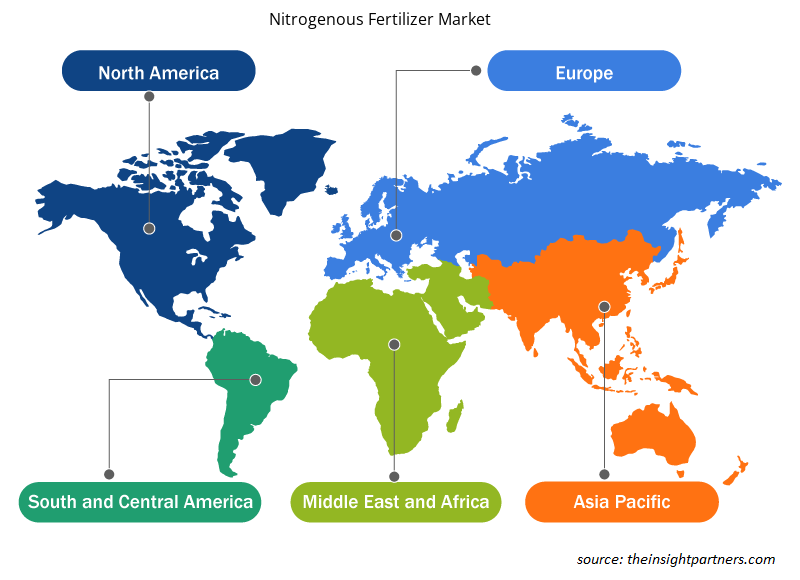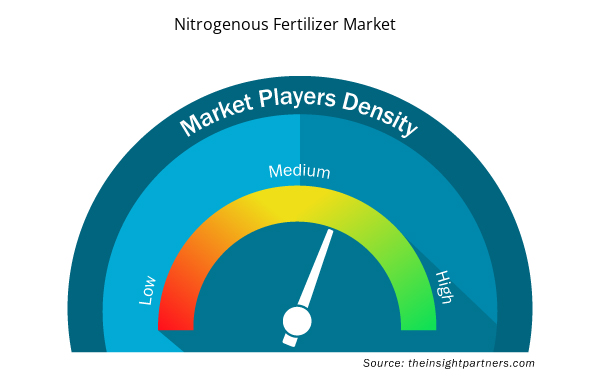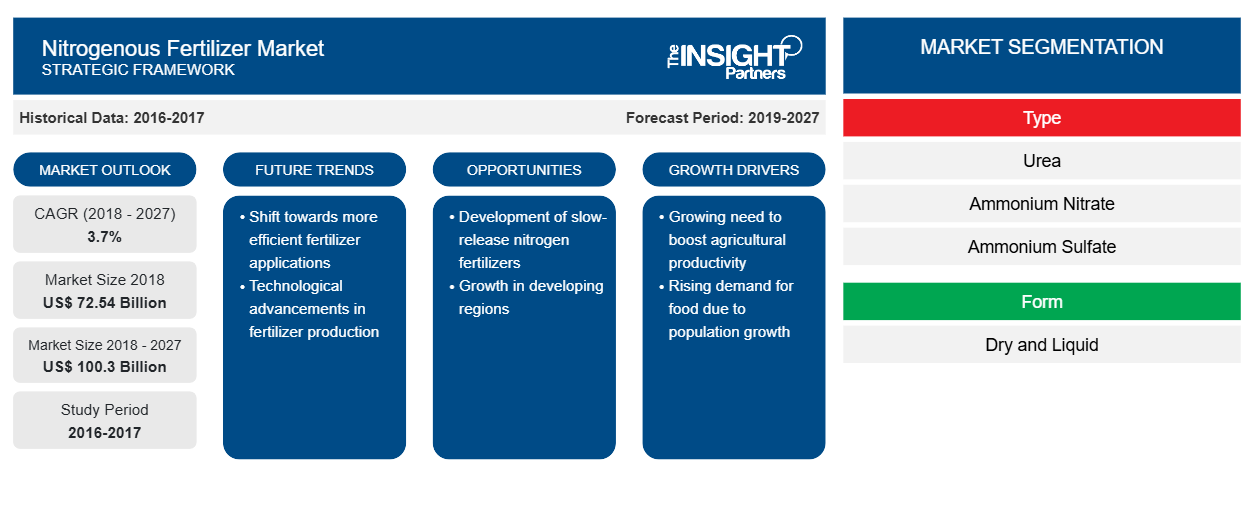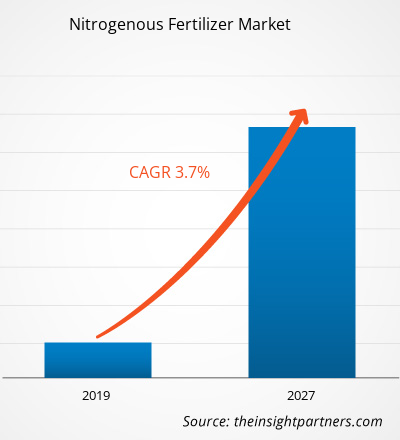2018 年氮肥市场价值为 725.3757 亿美元,预计 2019 年至 2027 年的复合年增长率为 3.7%,到 2027 年达到 1003.0442 亿美元。
氮肥是利用空气中的氮生产出来的,然后经过复杂的化学反应。氮用于促进农作物的生长,使植物的质地和颜色更好,从而有助于提高农业生产力。哈伯-博施法被认为是市场上最受欢迎的氮肥生产技术。天然气是哈伯-博施法使用的重要原料之一,与其他形式的原料如动物粪便和堆肥等一起用于该法。人口的增长带来了对粮食安全的需求,因此需要使用这种肥料来为土壤提供必需的养分,以改善土壤质量,最终提高产量。
预计北美氮肥市场在预测期内将以最高的复合年增长率增长。北美是氮肥增长最快的市场,因为在政府采取积极措施支持该行业增长的情况下,氮肥的应用不断增加。此外,可支配收入的增加加上对更好的农业设施的投资增加也可能推动北美市场对氮肥的需求。然而,使用此类合成肥料造成的环境和健康危害导致有机农产品的使用增加。这可能会阻碍氮肥市场的增长。
定制此报告以满足您的需求
您可以免费定制任何报告,包括本报告的部分内容、国家级分析、Excel 数据包,以及为初创企业和大学提供优惠和折扣
- 获取此报告的关键市场趋势。这个免费样品将包括数据分析,从市场趋势到估计和预测。
市场洞察
商业农业的增长
商业农业的基本定义是种植农作物,在国内或出口市场上出售产品以获取利润。商业农业已经进行了改革,并开启了农业领域的逐步发展。人口的增长加上改进技术和更好的基础设施的使用,对商业农业的发展产生了积极影响。农业产业的发展为采用技术和使用高质量肥料来提高产量奠定了基础,例如氮肥。因此,商业农业的增长将进一步导致对氮肥的需求增加。例如,包膜尿素的引入和使用,加上对混合 N、P 和 K 肥料的需求增加,以及采用酵母包膜肥料,在农业产业中已成为提高土壤肥力的突出举措。目前,大多数农业经营都采用了先进的机械和尖端技术。例如,土壤传感器和无人机的使用已成为大规模农业的重要组成部分,而垂直农业有望通过不使用阳光或土壤来收获农作物而取得多重进步。
产品洞察
根据应用,可细分为尿素、硝酸铵、硫酸铵、氨、硝酸铵钙等。尿素部分在 2018 年占据了全球市场的最大份额,而硫酸铵市场预计在预测期内将以最高的复合年增长率增长。硝酸铵是第一批大规模生产的固体氮源之一。硝酸铵肥料具有极强的挥发性,这使其在特定行业中受益。硝酸铵几乎是无色晶体盐,无味。在花园和大型农田中使用硝酸铵可改善植物生长,并为植物提供氮供应。硝酸铵肥料是一种生产简单的化合物。它是在氨气与硝酸反应时产生的。化学反应形成硝酸铵的浓缩配方,产生大量热量。作为肥料,该化合物被涂抹成颗粒,并与硫酸铵融合以降低化合物的挥发性。
应用程序洞察
根据作物类型,可分为谷物和谷类、油籽和豆类、水果和蔬菜等。谷物和谷类在 2018 年占据了最大的市场份额,而油籽和豆类预计在预测期内将实现最高的复合年增长率。所有油籽和豆类作物都需要适量的氮。氮是全球油籽和豆类生产中最受限制的养分。作物通常以硝态氮的形式从土壤中吸收大部分氮。当土壤氮含量充足时,氮会促进动态生长,使叶面积更大,颜色呈深绿色。土壤分析对于估计氮肥需求非常有用。全球对油和豆类的需求不断增长是氮肥扩张的主要因素之一。人们越来越倾向于健康的生活方式,这促进了油籽和豆类消费量的增加,因为它们对健康有益。因此,所有这些因素都刺激了氮肥市场的需求,也促进了全球市场的扩张。
氮肥市场中的一些参与者包括邦吉有限公司、CF Industries Holdings, Inc.、EuroChem Group、Koch Fertilizer, Llc、Nutrien Ltd. 和 OCI Nitrogen。主要公司实施并购和研发战略,以扩大客户群并在全球市场中获得显著份额,这也使他们能够在全球范围内保持自己的品牌名称。
报告亮点
- 氮肥市场的渐进式行业趋势,帮助参与者制定有效的长期战略
- 发达市场和发展中市场采用的业务增长战略
- 2019年至2027年氮肥市场定量分析
- 全球氮肥需求量估计
- PEST 分析可说明行业内买家和供应商的效率
- 了解竞争市场状况的最新发展
- 市场趋势和前景以及推动和抑制氮肥市场增长的因素
- 通过强调支撑商业利益的市场策略来协助决策过程,从而促进市场增长
- 各节点氮肥市场规模
- 市场的详细概述和细分,以及氮肥行业动态
- 各地区氮肥市场规模及增长潜力
氮肥市场区域洞察
Insight Partners 的分析师已详尽解释了预测期内影响氮肥市场的区域趋势和因素。本节还讨论了北美、欧洲、亚太地区、中东和非洲以及南美和中美洲的氮肥市场细分和地理位置。

- 获取氮肥市场的区域具体数据
氮肥市场报告范围
| 报告属性 | 细节 |
|---|---|
| 2018 年市场规模 | 725.4亿美元 |
| 2027 年市场规模 | 1003亿美元 |
| 全球复合年增长率(2018 - 2027) | 3.7% |
| 史料 | 2016-2017 |
| 预测期 | 2019-2027 |
| 涵盖的领域 | 按类型
|
| 覆盖地区和国家 | 北美
|
| 市场领导者和主要公司简介 |
|
市场参与者密度:了解其对商业动态的影响
氮肥市场正在快速增长,这得益于终端用户需求的不断增长,而这些需求又源于消费者偏好的不断变化、技术进步以及对产品优势的认识不断提高等因素。随着需求的增加,企业正在扩大其产品范围,进行创新以满足消费者的需求,并利用新兴趋势,从而进一步推动市场增长。
市场参与者密度是指在特定市场或行业内运营的企业或公司的分布情况。它表明在给定市场空间中,相对于其规模或总市场价值,有多少竞争对手(市场参与者)存在。
在氮肥市场运营的主要公司有:
- 邦吉有限公司
- CF 工业控股公司
- 欧洲化学集团
- 科赫化肥有限公司
- 纽特瑞恩有限公司
免责声明:上面列出的公司没有按照任何特定顺序排列。

- 了解氮肥市场主要参与者概况
氮肥市场-按类型
- 尿素
- 硝酸铵
- 硫酸铵
- 氨
- 硝酸铵钙
- 其他的
氮肥市场 – 按形式
- 干燥
- 液体
氮肥市场 – 按作物类型
- 谷物和谷类
- 油籽和豆类
- 水果和蔬菜
- 其他的
公司简介
- 邦吉有限公司
- CF 工业控股公司
- 欧洲化学集团
- 科赫化肥有限公司
- 纽特瑞恩有限公司
- OCI 氮气
- 沙特基础工业公司
- 中化化肥
- 托格里亚蒂亚索特 (TOAZ)
- 雅苒国际股份有限公司
- 历史分析(2 年)、基准年、预测(7 年)及复合年增长率
- PEST 和 SWOT 分析
- 市场规模价值/数量 - 全球、区域、国家
- 行业和竞争格局
- Excel 数据集



Report Coverage
Revenue forecast, Company Analysis, Industry landscape, Growth factors, and Trends

Segment Covered
This text is related
to segments covered.

Regional Scope
North America, Europe, Asia Pacific, Middle East & Africa, South & Central America

Country Scope
This text is related
to country scope.
常见问题
Among all six segments of product type, the ammonium sulfate is the fastest growing segment in the nitrogenous fertilizer market. Ammonium Sulfate is a chemical compound that is crystalline in nature primarily used to manufacture artificial alkaline soil fertilizers for agriculture. Ammonium Sulfate is inorganic and is a water-soluble salt containing 21% Nitrogen and 24% Sulfur. Ammonium sulfate's high nitrogen content makes it the perfect supplement for nitrogen deficient soils and lands. As lawn grass requires nitrogen, commercial lawn fertilizer products apply ammonium sulfate to stimulate quick growth of grass turf and healthy lawn grass. Ammonium sulfate fertilizers can easily blend with other nitrogen fertilizers allowing for a more stable, dry-lawn fertilizer.
The major players operating in the global nitrogenous fertilizer market are Bunge Limited, CF Industries Holdings, Inc., EuroChem Group, Koch Fertilizer, LLC, Nutrien Ltd, OCI Nitrogen, SABIC Group, Sinofert, Togliattiazot (TOAZ) and Yara International ASA among many others.
In 2018, the nitrogenous fertilizer market was predominant by Asia Pacific at the global level. The largest market share of the Asia Pacific region is primarily attributed to the rise in population and increase in demand for food. Further, the presence of large agricultural lands along with integration of advanced technology with the use of mineral fertilizers such as nitrogen based fertilizers is propelling the demand for nitrogenous fertilizer in this region. Moreover, the growing focus towards commercial farming is also expected to boost the demand for nitrogenous fertilizers in the region. The Asia Pacific market is characterized by the strong presence of players such as SABIC Group, Sinofert, Togliattiazot. and OCI Nitrogen among others.
Trends and growth analysis reports related to Chemicals and Materials : READ MORE..
The List of Companies - Global Nitrogenous Fertilizer Market
- Bunge Limited
- CF Industries Holdings, Inc.
- EuroChem Group
- Koch Fertilizer, Llc
- Nutrien Ltd.
- OCI Nitrogen
- SABIC Group
- Sinofert
- TOGLIATTIAZOT (TOAZ)
- Yara International ASA
The Insight Partners performs research in 4 major stages: Data Collection & Secondary Research, Primary Research, Data Analysis and Data Triangulation & Final Review.
- Data Collection and Secondary Research:
As a market research and consulting firm operating from a decade, we have published and advised several client across the globe. First step for any study will start with an assessment of currently available data and insights from existing reports. Further, historical and current market information is collected from Investor Presentations, Annual Reports, SEC Filings, etc., and other information related to company’s performance and market positioning are gathered from Paid Databases (Factiva, Hoovers, and Reuters) and various other publications available in public domain.
Several associations trade associates, technical forums, institutes, societies and organization are accessed to gain technical as well as market related insights through their publications such as research papers, blogs and press releases related to the studies are referred to get cues about the market. Further, white papers, journals, magazines, and other news articles published in last 3 years are scrutinized and analyzed to understand the current market trends.
- Primary Research:
The primarily interview analysis comprise of data obtained from industry participants interview and answers to survey questions gathered by in-house primary team.
For primary research, interviews are conducted with industry experts/CEOs/Marketing Managers/VPs/Subject Matter Experts from both demand and supply side to get a 360-degree view of the market. The primary team conducts several interviews based on the complexity of the markets to understand the various market trends and dynamics which makes research more credible and precise.
A typical research interview fulfils the following functions:
- Provides first-hand information on the market size, market trends, growth trends, competitive landscape, and outlook
- Validates and strengthens in-house secondary research findings
- Develops the analysis team’s expertise and market understanding
Primary research involves email interactions and telephone interviews for each market, category, segment, and sub-segment across geographies. The participants who typically take part in such a process include, but are not limited to:
- Industry participants: VPs, business development managers, market intelligence managers and national sales managers
- Outside experts: Valuation experts, research analysts and key opinion leaders specializing in the electronics and semiconductor industry.
Below is the breakup of our primary respondents by company, designation, and region:

Once we receive the confirmation from primary research sources or primary respondents, we finalize the base year market estimation and forecast the data as per the macroeconomic and microeconomic factors assessed during data collection.
- Data Analysis:
Once data is validated through both secondary as well as primary respondents, we finalize the market estimations by hypothesis formulation and factor analysis at regional and country level.
- Macro-Economic Factor Analysis:
We analyse macroeconomic indicators such the gross domestic product (GDP), increase in the demand for goods and services across industries, technological advancement, regional economic growth, governmental policies, the influence of COVID-19, PEST analysis, and other aspects. This analysis aids in setting benchmarks for various nations/regions and approximating market splits. Additionally, the general trend of the aforementioned components aid in determining the market's development possibilities.
- Country Level Data:
Various factors that are especially aligned to the country are taken into account to determine the market size for a certain area and country, including the presence of vendors, such as headquarters and offices, the country's GDP, demand patterns, and industry growth. To comprehend the market dynamics for the nation, a number of growth variables, inhibitors, application areas, and current market trends are researched. The aforementioned elements aid in determining the country's overall market's growth potential.
- Company Profile:
The “Table of Contents” is formulated by listing and analyzing more than 25 - 30 companies operating in the market ecosystem across geographies. However, we profile only 10 companies as a standard practice in our syndicate reports. These 10 companies comprise leading, emerging, and regional players. Nonetheless, our analysis is not restricted to the 10 listed companies, we also analyze other companies present in the market to develop a holistic view and understand the prevailing trends. The “Company Profiles” section in the report covers key facts, business description, products & services, financial information, SWOT analysis, and key developments. The financial information presented is extracted from the annual reports and official documents of the publicly listed companies. Upon collecting the information for the sections of respective companies, we verify them via various primary sources and then compile the data in respective company profiles. The company level information helps us in deriving the base number as well as in forecasting the market size.
- Developing Base Number:
Aggregation of sales statistics (2020-2022) and macro-economic factor, and other secondary and primary research insights are utilized to arrive at base number and related market shares for 2022. The data gaps are identified in this step and relevant market data is analyzed, collected from paid primary interviews or databases. On finalizing the base year market size, forecasts are developed on the basis of macro-economic, industry and market growth factors and company level analysis.
- Data Triangulation and Final Review:
The market findings and base year market size calculations are validated from supply as well as demand side. Demand side validations are based on macro-economic factor analysis and benchmarks for respective regions and countries. In case of supply side validations, revenues of major companies are estimated (in case not available) based on industry benchmark, approximate number of employees, product portfolio, and primary interviews revenues are gathered. Further revenue from target product/service segment is assessed to avoid overshooting of market statistics. In case of heavy deviations between supply and demand side values, all thes steps are repeated to achieve synchronization.
We follow an iterative model, wherein we share our research findings with Subject Matter Experts (SME’s) and Key Opinion Leaders (KOLs) until consensus view of the market is not formulated – this model negates any drastic deviation in the opinions of experts. Only validated and universally acceptable research findings are quoted in our reports.
We have important check points that we use to validate our research findings – which we call – data triangulation, where we validate the information, we generate from secondary sources with primary interviews and then we re-validate with our internal data bases and Subject matter experts. This comprehensive model enables us to deliver high quality, reliable data in shortest possible time.


 获取此报告的免费样本
获取此报告的免费样本